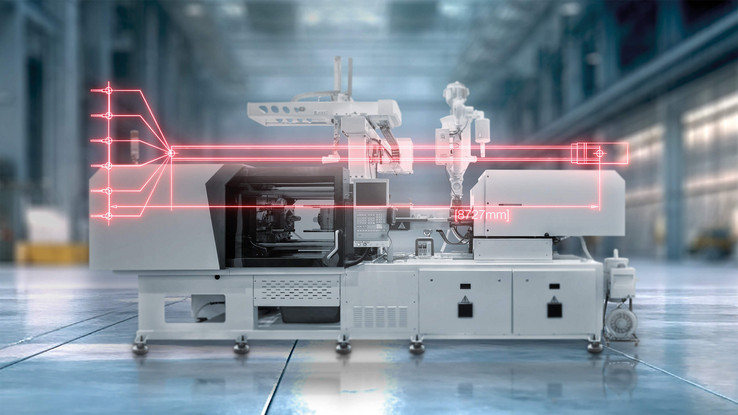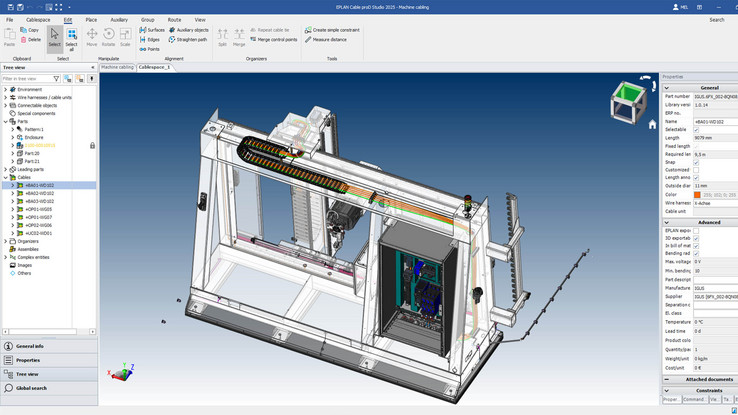Design Cable Pathways in 3D
New tool for machine cabling
Pre-assembled cables from the control cabinet to the machine? At the correct lengths and with well-designed cable routing? Starting from September, this will be possible using the software EPLAN Cable proD. In Hanover, Germany, those interested will be able to get a first impression of how they can define cabling routes within the 3D model. The best part is that MCAD data and information from EPLAN Electric P8 and EPLAN Pro Panel can easily be integrated – connecting the electrical engineering designs with the mechanical designs.
How can the advantages of pre-assembled cables be utilised in mechanical engineering? Not every machine builder has asked themselves this question – yet it is high time to start saving money and resources using plug-and-play methods. Solutions provider EPLAN has had the topic of machine cabling in its sights for some time now and will be presenting a preview of EPLAN Cable proD at this year’s Hannover Messe. The product, which has been specially developed for machine cabling, is intended to close the existing gaps. While control cabinets can already be perfectly designed and their digital twins used in production, there is still a lot of unused potential to be exploited in cabling processes. Until now, there has often not been enough information to ensure smooth cabling planning and installation.
Eliminating errors from the outset
It goes almost without saying that current working methods can be error-prone and time-consuming. Companies are increasingly recognising the need to take action here, since cables are a significant cost factor. If they are too short, too long, or even incorrectly planned, costs increase. If a cable is planned by eyeballing it, things can get tricky. Interference signals can lead to malfunctions and long commissioning times – such signals are not only difficult to localise, but can also end up being extremely time-consuming and costly.
Focus on the digital twin
Wouldn’t it be better to know the exact cable lengths from the very start, particularly considering the use of pre-assembled cables, which are becoming increasingly popular nowadays? While this is of course true, it does require the right tools and data – ideally based on a digital twin. EPLAN Cable proD is a 3D software that allows exactly this twin to be created and serves as the foundation for machine cabling. The cable planning process is quite easy. Designers can plan the appropriate cable routing in EPLAN Cable proD, which they would otherwise have to determine on a physical prototype. So they now have the exact details for the required cable lengths much earlier in the planning process, making them significantly more efficient thanks to the early digital designs. Interfaces to all common mechanical engineering CAD tools ensure that data can be read in natively and then output in universal data formats.
EPLAN takes machine cabling very seriously, which is shown in the upcoming expansion in the EPLAN Platform 2025. Once released, pre-assembled cables can be designed and planned in EPLAN Electric P8 – with direct data transfer to EPLAN Cable proD, of course.
The benefits are clear:
- Exact planning: the digital twin eliminates the need for a physical prototype
- Precise data: for planning, work preparation, manufacturing, assembly and service
- Greater productivity: pre-assembled cables can be utilised
- Lower costs: no cable waste/no warehousing of materials
- Planning reliability: the cables fit when the machine is assembled and commissioned
What only first becomes clear on a prototype in the traditional way of working becomes visible much earlier through this integrative process. For instance, changes that occur when building a prototype can be made with just a few mouse clicks on the computer. A physical counterpart in production or the workshop is no longer required.
Background
Machine builders are faced with challenges when supply chain are often interrupted. As increasing numbers of electronics and sensors are being installed in modern machines, this makes these more complex machines more susceptible to delivery delays. Another challenge is that the competition with low-wage countries is increasing, not to mention the shortage of skilled workers. Efficiency is therefore the watchword for today, which applies to planning and designing machines, to the control cabinets, and not least to the connection between the machine and control cabinet.




